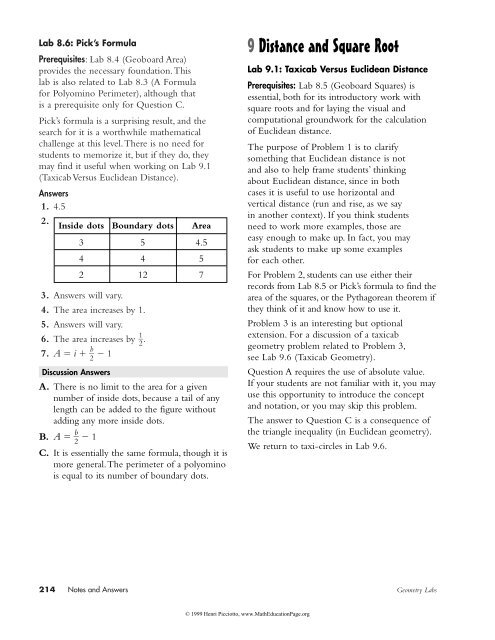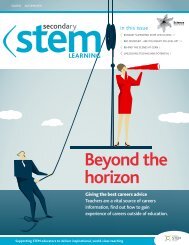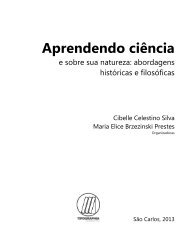Create successful ePaper yourself
Turn your PDF publications into a flip-book with our unique Google optimized e-Paper software.
Lab 8.6: Pick’s Formula<br />
Prerequisites: Lab 8.4 (Geoboard Area)<br />
provides the necessary foundation.This<br />
lab is also related to Lab 8.3 (A Formula<br />
for Polyomino Perimeter), although that<br />
is a prerequisite only for Question C.<br />
Pick’s formula is a surprising result, and the<br />
search for it is a worthwhile mathematical<br />
challenge at this level.There is no need for<br />
students to memorize it, but if they do, they<br />
may find it useful when working on Lab 9.1<br />
(Taxicab Versus Euclidean Distance).<br />
Answers<br />
1. 4.5<br />
2.<br />
Inside dots Boundary dots Area<br />
3 5 4.5<br />
4 4 5<br />
2 12 7<br />
3. Answers will vary.<br />
4. The area increases by 1.<br />
5. Answers will vary.<br />
6. The area increases by 1 2 .<br />
b<br />
7. A i 1<br />
2<br />
Discussion Answers<br />
A. There is no limit to the area for a given<br />
number of inside dots, because a tail of any<br />
length can be added to the figure without<br />
adding any more inside dots.<br />
b<br />
B. A 2 1<br />
C. It is essentially the same formula, though it is<br />
more general.The perimeter of a polyomino<br />
is equal to its number of boundary dots.<br />
9 Distance and Square Root<br />
Lab 9.1: Taxicab Versus Euclidean Distance<br />
Prerequisites: Lab 8.5 (Geoboard Squares) is<br />
essential, both for its introductory work with<br />
square roots and for laying the visual and<br />
computational groundwork for the calculation<br />
of Euclidean distance.<br />
The purpose of Problem 1 is to clarify<br />
something that Euclidean distance is not<br />
and also to help frame students’ thinking<br />
about Euclidean distance, since in both<br />
cases it is useful to use horizontal and<br />
vertical distance (run and rise, as we say<br />
in another context). If you think students<br />
need to work more examples, those are<br />
easy enough to make up. In fact, you may<br />
ask students to make up some examples<br />
for each other.<br />
For Problem 2, students can use either their<br />
records from Lab 8.5 or Pick’s formula to find the<br />
area of the squares, or the Pythagorean theorem if<br />
they think of it and know how to use it.<br />
Problem 3 is an interesting but optional<br />
extension. For a discussion of a taxicab<br />
<strong>geometry</strong> problem related to Problem 3,<br />
see Lab 9.6 (Taxicab Geometry).<br />
Question A requires the use of absolute value.<br />
If your students are not familiar with it, you may<br />
use this opportunity to introduce the concept<br />
and notation, or you may skip this problem.<br />
The answer to Question C is a consequence of<br />
the triangle inequality (in Euclidean <strong>geometry</strong>).<br />
We return to taxi-circles in Lab 9.6.<br />
214 Notes and Answers Geometry Labs<br />
© 1999 Henri Picciotto, www.MathEducationPage.org






